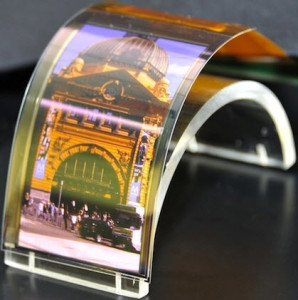
Organic light emitting diodes or OLEDs
originated from the class of LEDs as one of the major display
technologies that differs with low power and combination of great
colors. OLED technology uses the principle of electroluminescence which
can be stated as the optical and electrical phenomenon wherein certain
materials emit light in response to an electric current passing through
it. These OLEDs are used to create digital displays in devices such as
TV screens, computer monitors and portable systems like mobile phones,
mp3 players and digital cameras, etc. These diodes are about 100 to 500
nanometers thick and 200 times smaller than human hair.
OLED displays are very expensive than LCD displays
because they use ink-jet printing technology and sprays conductive
polymer substances instead of ink. OLED displays are advantageous as
they are bright, clear, thin, light in weight, and possess an efficient
viewing angle. Apart from this, they can be taken on various surfaces
and can be printed on various surfaces. OLED lighting contains no
mercury, and thus eliminates the disposal and pollution problems
associated with the fluorescent lighting.
Architecture of OLED Technology
OLED structure has many thin layers of
organic material. These OLEDs compose of aggregates of Amorphous and
crystalline molecules arranged in irregular pattern. When current passes
through these thin layers, light gets emitted from their surface by a
process of electro phosphorescence. OLEDs work on the principle of
electro-luminescence, and this can be achieved by using multi-layered
devices. In between these multi-layered devices, there are several thin
and functional layers that are sandwiched between the electrodes.
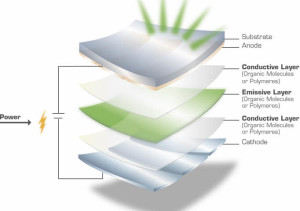
When Direct Current is applied, charge
carriers from the anode and cathode are injected into organic layers,
due to electroluminescence visible light gets emitted.
The architecture of OLED display
comprises several layers: two or three organic layers like conducting
layer, emissive layer and other layers such as substrate, anode and
cathode layers that are explained below in detail.
Substrate Layer: This
layer is a thin sheet of glass with a transparent conductive layer,
which can also be made by a clear plastic layer or foil. This substrate
supports the OLED structure.
Anode Layer: This layer
is an active layer and removes electrons. When current flows through
this device, electrons are replaced by electron holes. Thin layers are
deposited onto anode surface, and therefore, it is also known as
transparent layer. Indium tin oxide is the best example of this layer
that serves as the bottom of the electrode or anode.
Conductive Layer:
Conductive layer is an important part in this structure that transports
the holes from the anode layer. This layer is made up of organic
plastic, and the polymers used include light-emitting
polymers, polymer light-emitting diode, etc. The conductive polymer
used in OLED are polyaniline, polyethylenedioxythiophene. This layer is
an electroluminescent layer and uses the derivatives of p-phenylene
vinylene and polystyrene.
Emissive layer: This
layer transports electrons from anode layers, and it is made of organic
plastic molecules that are different from the conducting layers. There
are multiple choices of materials and processing variables such that a
wide range of wavelengths can be emitted during emission. In this layer,
two polymers are used for emitting such as polyfluorene, poly para
phenylene which normally emits green and blue lights. This layer is made
of special organic molecules that conduct electricity.
Cathode Layer: Cathode
layer is responsible for injection of electrons when current flows
through the device. Making of this layer is done by using calcium,
barium, aluminum and magnesium. It may be either transparent or opaque
depending on the type of OLED.
Working of OLED
The conductive layer and emissive layers are made of special organic molecules that are helpful in conducting electricity. Anode and cathode are used for connecting OLEDs to the source of electricity.
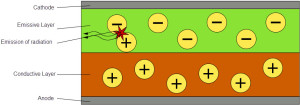
When power is applied to an OLED, the
emissive layer becomes negatively charged and the conductive layer
becomes positively charged. Due to electrostatic forces applied, the
electrons move from the positive conductive layer to a negative emissive
layer. This may lead to a change in electrical levels and creates
radiation that varies in frequency range of visible light.
OLEDs also work as diodes if current
flows through them in correct direction. The anode layer connected above
the emissive layer is at a higher potential compared to the cathode
connected to the conductive layer for the working of OLEDs.
Types of OLEDs
Based on the structure of OLEDs, they are classified into different types:
1. Passive OLED: The
organic layers that run perpendicularly between the strips of the anode
and the cathode are known as Passive OLEDs. These OLEDs describe about
the external circuitry and pixel information. These OLEDs are easy to
make, and use more power and best options for small screens.
2. Active matrix OLED: This OLED requires a thin-film transistor
to place on the top of the anode layer. These OLEDs require less power
and are suitable for large screen displays. Anode is used to control
pixels. All the other layers such as cathode and organic molecules are
similar to a typical OLED.
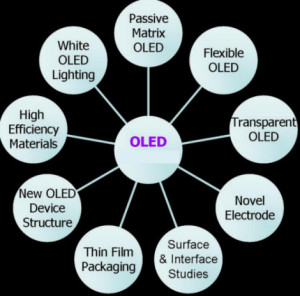
4. Top emitting OLED:
The substrate layer in this OLED may be reflective or non- reflective
and the cathode layer is transparent. These OLEDs are used with the
active matrix devices and in the making of smart card displays.
5. White OLED: These OLEDs emit only white light and are used in the making of larger and efficient lighting systems. These OLEDs replace the fluorescent lights, and the energy cost is reduced for lighting.
6. Foldable OLED: These
OLEDs are made up of flexible metallic foil or plastic substrate. This
flexible OLED display technology has the characteristics like light
weight, ultra-thin stature, and thus reduces the breaking of electronic
display boards.
7. Phosphorescent OLED:
This OLED works on the principle of electroluminescence used to convert
100 % of the electrical energy into light. The specifications of these
OLEDs are amazing as they reduce heat generation; operate at very low
voltage and have a long operating life time.
Applications of OLED Display Technology
- TVs
- Cellphone screens
- Computer screens
- Keyboards
- Lights
- Portable device displays
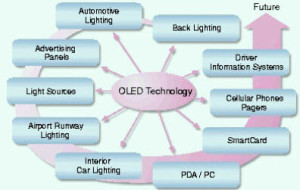
1. OLED Televisions
Sony application: Sony
released XEL-1 in the year February, 2009. The first OLED TV sold in all
stores had high resolutions and these specifications: 11” screen and
3mm thin. The approximate weight of this TV was 1.9 kg, along with a 178
degrees wide range of viewing angle.
LG applications: In the
year 2010, LG had produced new OLED television with a 15 inch screen,
15EL9500, and announced an OLED 3D television with these specifications:
31” screen and 78cm in the year March, 2011.
Mitsubishi applications:
Lumiotec is the first company in the world that has been developing and
selling mass produced OLED lighting panels with immense brightness and
long lifetime since January 2011. Luiotec is the joint venture of
Mitsubishi heavy industries.
2. Keyboards: In
Optimus Maximus Keyboard type of keyboard keys are linked to display
notes, applications, numerals, etc., through programming to perform a
series of functions.
Thus, the OLED system gives exceptional display compared to other display systems.
Due to its robust design, these systems come in several portable
devices like cell phones, DVD players, digital video cameras, etc. And,
this is the weight and space saving technology. Finally, the
applications of OLEDs are being continuously expanding, and – as a
matter of fact – this is definitely going to be the best display
technology in the future. We anticipate your comments and suggestions
pertaining to this OLED technology in the comments section below.






No comments:
Post a Comment